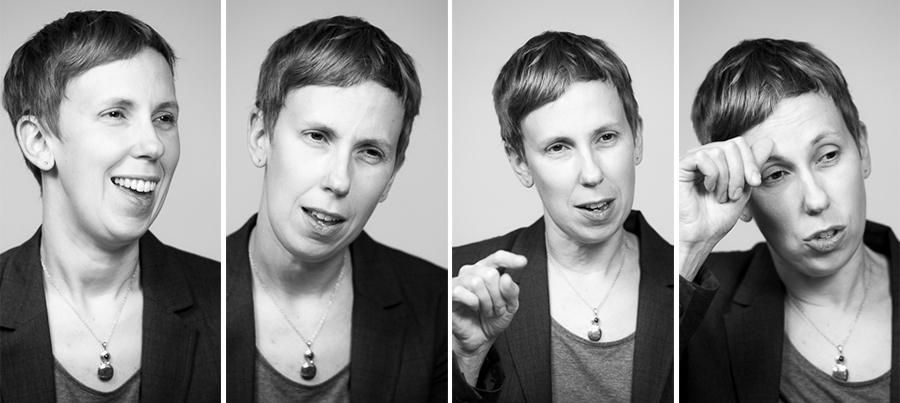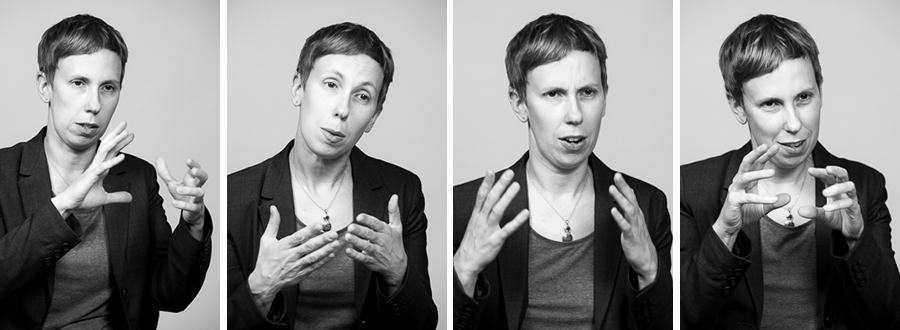Amy Steinbugler

Photos by Carl Socolow '77.
FOCUS ON FACULTY
by Christine Baksi
Assistant Professor of Sociology Amy Steinbugler discusses how race shapes relationships and the challenges of ethnographic research.
Your first book, Beyond Loving: Intimate Racework in Lesbian, Gay, and Straight Interracial Relationships, has been well received by fellow sociologists. Tell us about the accolades it has garnered and how it advances our understanding of the role race plays in family and interpersonal relationships.
This year Beyond Loving won two awards from the American Sociological Association—the Distinguished Book Award from the Sexualities Section and the William J. Goode Book Award from the Family Section. A main goal of the book was to examine more carefully how race shapes intimate relationships. I look at the array of actions and strategies that interracial couples—black/white couples in particular—use to negotiate race in everyday life. My reading of popular media accounts—and even some social science research—on interracial intimacy is that interracial couples are commonly portrayed as racial mavericks who have somehow gotten beyond the ugliness of racism. The idea is that the complexities of racial inequality melt away in the context of loving relationships. To me, that notion seems fundamentally wrong-headed. We know, for instance, from generations of feminists and family scholars that gendered roles and expectations between women and men do not disappear in the context of heterosexual unions. People who love each other still struggle over housework, childcare and who pays the bills. Gender shapes intimate relationships in important ways. And so too does race. I feel tremendously honored if my colleagues found some of these ideas useful.
In what ways does your work clarify common misunderstandings about racial dynamics in same-sex and heterosexual couples?
Well, the most significant misunderstanding might be the assumption that all interracial couples are straight. Most studies on interracial intimacy take heterosexual couples as the focus. Mine is one of very few that considers the experiences of lesbian and gay couples. And to be clear: We should study what interracial life is like for heterosexual black/white couples in the U.S. because of the history of racial and sexual violence associated with these pairings. But when we ignore same-sex couples and allow the experiences of heterosexual couples to stand in for everybody, we get some important things wrong. We mistakenly assume that partners on the street or in a restaurant are immediately recognized as an interracial couple. We expect that a couple’s racial difference is the main thing that sets them apart from the everyday image of a “regular couple.” Or we suppose that in public spaces, interracial couples are most attuned to racial dynamics. But these things are not universal characteristics of interracial couples—they just describe what it’s like to be a straight black/white pair. For lesbian and gay interracial couples, things are a little different. Heterosexism shapes what it feels like to be a black/white couple. Lesbian and gay partners often feel that their relationship is unrecognizable to strangers in public places, and they’re constantly reading both racial and sexual cues in order to know whether it might be OK to hold hands, for instance, or exchange a kiss. In many ways, their experiences are qualitatively different from their straight counterparts. Their lives tell us important things about what it means to love and create families outside of the mainstream.

Photos by Carl Socolow '77.
Your current project is an ethnographic study of an economically diverse Philadelphia neighborhood. How does this research methodology help advance your work?
Ethnographic research can be so exciting and also entirely exhausting. One of my mentors likes to say that ethnography is a young person’s game, and I’m beginning to believe her. The basic logic within ethnographic methods is that if we want to understand a social setting, our best strategy is to carefully observe that space. What kind of interactions take place? What is the nature of social relationships there? What are the rules of the game? This is the kind of work that you can’t do from your office computer. You need to go out and talk to people. You have to hang out. Watch. Listen. Try to understand where you are and what’s going on around you. For me, the challenge has been to think about the boundaries of my project. When you study a community, or a group of communities, where does the project start and end? One person can cover only so much ground. I have had to start small, with a few organizations in this area of Philly, and try to understand how people work together (and when they don’t) to try to improve their community.
Based on your research, to what extent do our neighborhoods affect our life chances?
That’s an important question. As someone who studies social stratification, I’ve always had a sense that inequality is grounded in place. But having the opportunity to think more deeply about these issues—in my research and in class with my students—has been illuminating. A big part of understanding the influence of a neighborhood is recognizing its impact, independent of the individuals who live there. Social opportunities and constraints are organized spatially. Take public schools, for instance. Because they are funded largely by local property taxes, schools in wealthy neighborhoods are able to spend much more money per kid than schools in poor neighborhoods. The quality of public amenities like parks, libraries and recreation areas also are dependent on the economic status of a neighborhood. So is the negative stuff—exposure to violence and gangs, and environmental toxins and pollutants. I think that many Americans understand these patterns intuitively, and middle-class folks regularly try to maximize as much of the good stuff as possible with their home-buying dollars. The key, though, is not to help everyone move away from “bad neighborhoods” but to improve the most impoverished neighborhoods (and the institutions within them) so that they are safe and healthy places to live.
Suggested reading
Stefanie K. Dunning. 2009. Queer in Black and White: Interraciality, Same-Sex Desire, and Contemporary African American Culture. Indiana University Press.
Robert Sampson. 2013. Great American City: Chicago and the Enduring Neighborhood Effect. University of Chicago Press.
Patrick Sharkey. 2013. Stuck in Place: Urban Neighborhoods and the End of Progress Toward Racial Equality. University of Chicago Press.
Read more Focus on Faculty profiles.
Published October 14, 2014